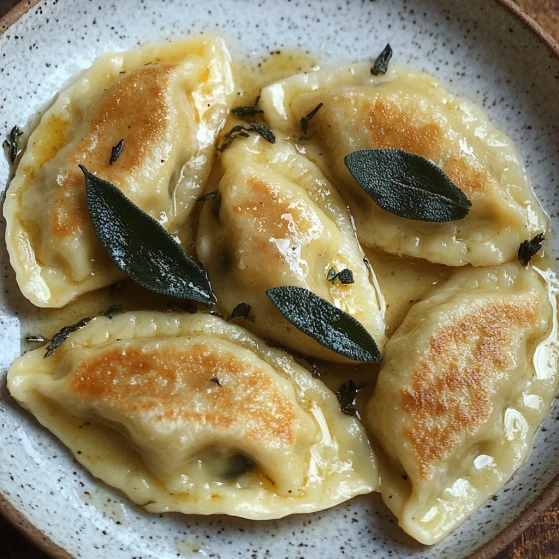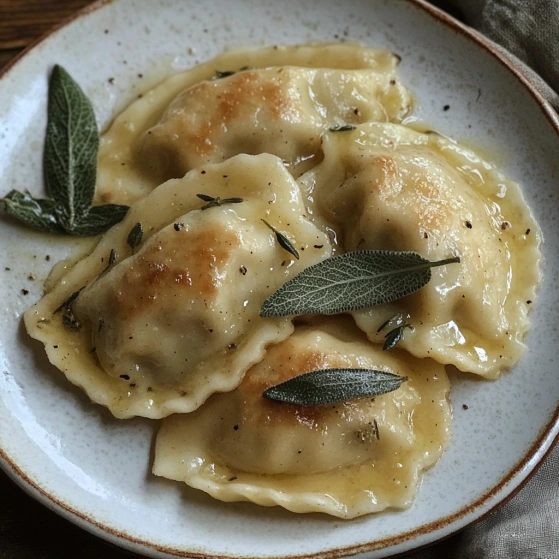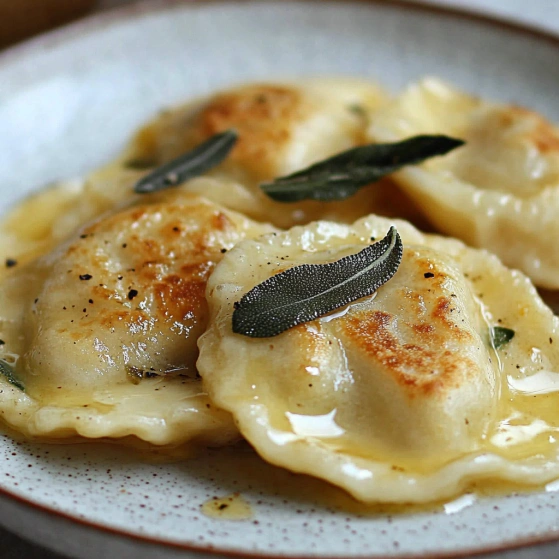 Pin it
Pin it
This rustic homemade pierogi recipe transforms simple ingredients into pillowy dumplings bathed in nutty brown butter and fragrant sage. Perfect for cozy dinners, these Polish-inspired dumplings balance creamy potato filling with crispy, buttery exteriors.
I first learned this recipe from my Polish neighbor who insisted the secret was browning the butter until just nutty but not burnt. After years of making these pierogi, they've become my most requested dish when friends visit for dinner.
Ingredients
- Russet potatoes: perfect for their starchy texture and ability to create a smooth filling
- Onions: sautéed until golden add sweet depth to the potato filling
- Fresh sage leaves: that crisp beautifully in brown butter
- Unsalted butter: allows you to control the salt level and develops the richest flavor when browned
- Sour cream: adds tanginess and creaminess to the filling
- Cheddar cheese: use sharp varieties for more pronounced flavor
- All purpose flour: creates a pliable dough that holds filling perfectly
- Egg: helps bind the dough and creates a tender texture
Step-by-Step Instructions
- Prepare the potatoes:
- Place peeled and halved russet potatoes in cold water, bring to a boil, and cook for 20-25 minutes until absolutely fork tender. Starting in cold water ensures even cooking through the potatoes. Test doneness by easily sliding a fork into the center with no resistance.
- Sauté the onions:
- While potatoes cook, melt 2 tablespoons butter in a saucepan over medium heat until foaming subsides. Add chopped onions and cook slowly for 8-10 minutes, stirring occasionally until they turn a rich golden brown. This caramelization develops deep flavor compounds that make the filling extraordinary.
- Make the dough:
- Combine flour, warm water, olive oil, beaten egg and a pinch of salt in a medium bowl. Mix first with a fork until shaggy, then use your hands to knead for 2-3 minutes until smooth and slightly elastic. The dough should feel tacky but not sticky. Shape into a disc, wrap tightly, and refrigerate for at least 30 minutes to relax the gluten.
- Prepare the filling:
- Drain cooked potatoes thoroughly and transfer to a bowl. Immediately add shredded cheddar so it melts into the hot potatoes. Mix in the sautéed onions, sour cream, salt and pepper. Mash thoroughly until very smooth with no lumps, then taste and adjust seasoning. Cover and chill for 15 minutes to firm up for easier handling.
- Roll and cut the dough:
- On a lightly floured surface, roll chilled dough to about ⅛-inch thickness. Use a pint glass to cut circles about 3 inches in diameter. Gather scraps, reroll after a 5-minute rest, and cut more circles. Keep covered with plastic wrap to prevent drying.
- Fill and seal pierogi:
- Place a rounded tablespoon of potato filling in the center of each dough circle. Gently stretch the edges around the filling and pinch firmly to seal completely. Ensure no filling leaks out or the pierogi may burst when cooking. If dough becomes too warm and difficult to work with, chill for 10 minutes.
- Boil the pierogi:
- Bring a large pot of generously salted water to a rolling boil. Cook pierogi in batches of 6-8 for exactly 3 minutes until they float to the surface. Carefully remove with a slotted spoon to an oiled bowl to prevent sticking.
- Brown butter finish:
- In a large nonstick pan, melt remaining 4 tablespoons butter over medium-high heat. Add sage leaves and cook until butter turns amber and smells nutty, about 2-3 minutes. Watch carefully as it can burn quickly. Add boiled pierogi and pan-fry until golden and crisp on both sides, about 2 minutes per side.
 Pin it
Pin it
My grandmother always added a pinch of nutmeg to her potato filling, saying it wakens the palate. When I make these pierogi, the aroma of browning butter and sage immediately takes me back to her tiny kitchen where she would let me help crimp the edges of each dumpling.
Make-Ahead Options
These pierogi excel as a make-ahead meal. After sealing the dumplings, place them on a parchment-lined baking sheet without touching, freeze until solid (about 2 hours), then transfer to freezer bags. When ready to cook, drop the frozen pierogi directly into boiling water and add 1-2 minutes to the cooking time. The brown butter finish can be done just before serving.
 Pin it
Pin it
Serving Suggestions
Serve pierogi with additional sour cream on the side for dipping. For a complete meal, pair with a simple cucumber salad dressed with dill, vinegar and a touch of sugar to cut through the richness. A glass of crisp Polish beer or dry Riesling complements the flavors beautifully. For a heartier meal, serve alongside kielbasa sausage with sauerkraut.
Historical Context
Pierogi have been a staple in Polish cuisine since the 13th century. Traditionally filled with farmer's cheese, potatoes, sauerkraut, or seasonal fruits, these dumplings were associated with harvest celebrations. The brown butter sage variation comes from a more modern, chef-inspired approach that maintains the pierogi's comforting essence while adding sophistication. In many Polish families, pierogi making is a communal activity where generations gather to prepare hundreds at once.
Troubleshooting
If your dough feels too sticky, add flour one tablespoon at a time until it reaches a workable consistency. For dough that seems too dry, wet your hands slightly while kneading. When boiling pierogi, avoid crowding the pot which can make them stick together. If pierogi stick to each other after boiling, gently separate them with a spoon coated in olive oil.
Frequently Asked Questions
- → Can I make these pierogi ahead of time?
Yes! You can prepare the dough and filling a day in advance (store separately in the refrigerator). You can also freeze fully assembled uncooked pierogi for up to 3 months - freeze them in a single layer before transferring to a freezer bag. Cook directly from frozen, adding 1-2 minutes to the boiling time.
- → What can I substitute for the cheese in the filling?
You can substitute the cheddar with other melting cheeses like Gouda, Gruyère, or farmer's cheese for a more traditional approach. For a dairy-free version, try using a plant-based cheese alternative or simply omit it and add more caramelized onions for flavor.
- → What's the best way to serve these pierogi?
These pierogi are delicious served with additional sour cream on the side. They pair well with a simple green salad or braised cabbage. For a heartier meal, serve alongside grilled kielbasa or other smoked sausages.
- → Why did my pierogi burst when boiling?
Bursting usually happens when the edges aren't sealed properly or when the water is boiling too vigorously. Ensure you pinch the edges firmly and use a fork to crimp them if needed. Keep the water at a gentle boil rather than a rolling boil, and don't overcrowd the pot.
- → Can I use other herbs instead of sage?
While sage pairs wonderfully with brown butter, you can substitute with other herbs like thyme or rosemary. Fresh herbs work best for this dish, but if using dried herbs, use about 1/3 the amount called for in the recipe and add them earlier in the cooking process.
- → How do I know when the brown butter is ready?
Brown butter is ready when it develops a nutty aroma and the milk solids at the bottom of the pan turn golden brown. Watch it carefully as it can quickly go from brown to burnt. The butter will foam first, then the foam will subside, and you'll see brown specks forming - that's when it's done.
